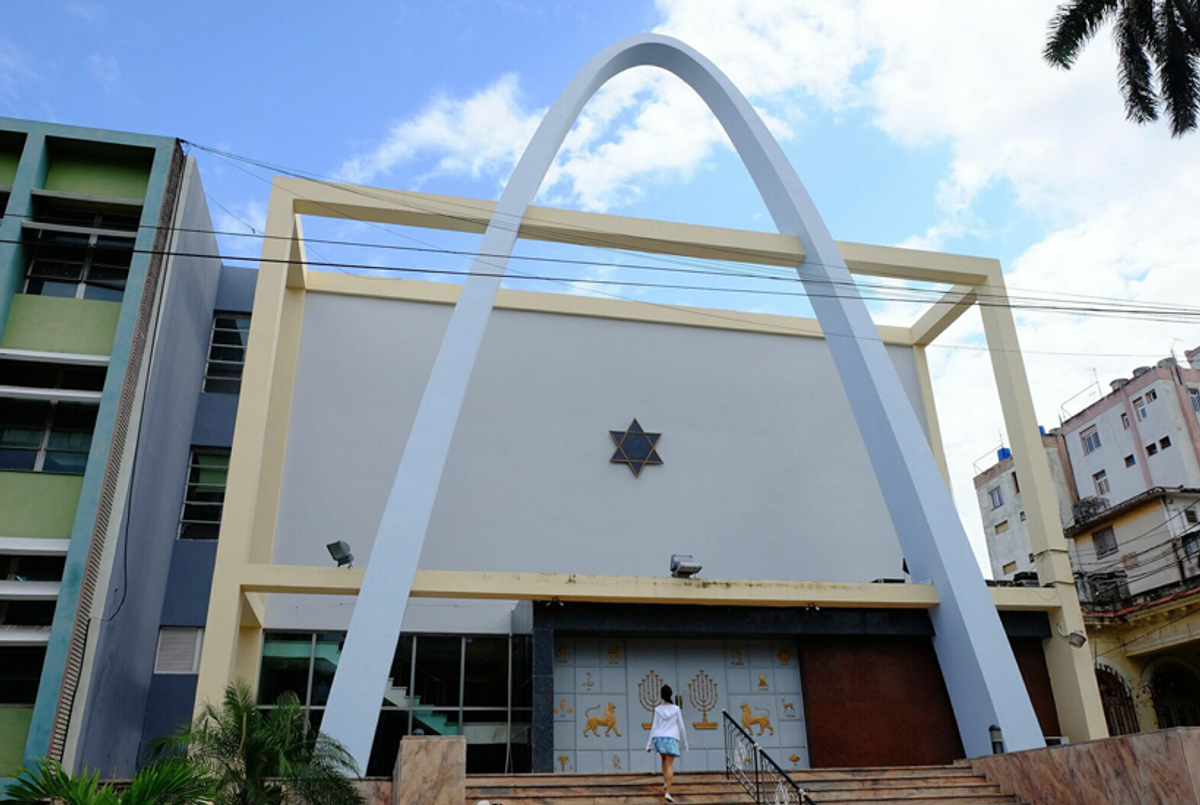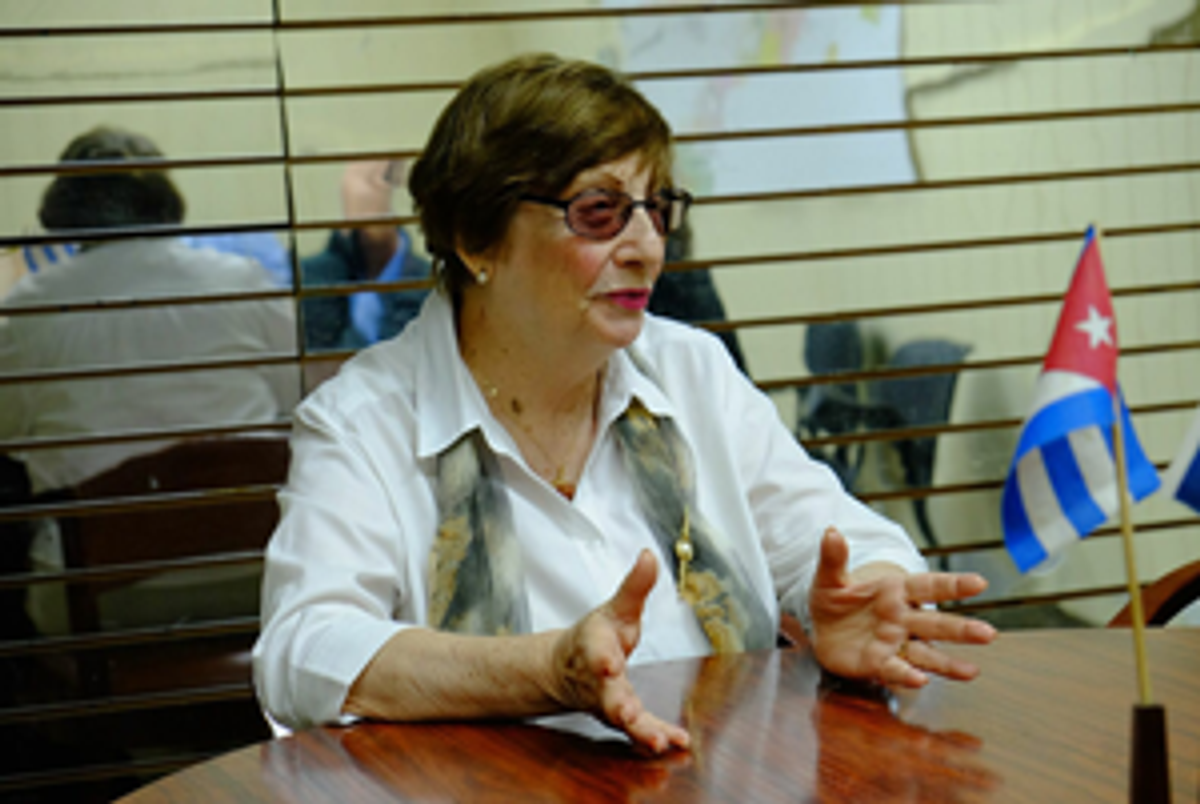
Our bags, tagged for Cuba, were crammed with things we were told Jewish Cubans needed: antibiotics, pain relievers, reading glasses, pens and pencils, art supplies, Spanish children’s books on Hanukkah, guitar strings, baseballs, and deflated soccer balls, each with its own inflation pin taped to the side. Heavy on pharmaceuticals, our luggage was light on bathing suits. The fabled beaches of Cuba, filled with Canadian and European tourists sipping mojitos, were not for us. United States policy has limited travel to Cuba since 1963, so group trips with an educational or religious focus are the only legal way for Americans to visit. In return, Cuba restricts U.S. groups to tours led by Cuban government guides, who leave little time for lounging on the beach.
With the new rapprochement, U.S. tourism to Cuba is booming. Jews, it turns out, make up a noticeable minority of those going. And we go for several reasons. Like other travelers there, we want to see old, picturesque Cuba before it becomes (again) Las Vegas on the Caribbean. We want to visit coreligionists, especially coreligionists who live someplace exotic. And then Jewish tourism to Cuba includes a healthy dose of chesed, evidenced by our donation-stuffed bags.
It was for a mix of these reasons that Rabbi Allan Berkowitz helped initiate the February 2015 trip for our group of 14 friends from a Conservative congregation in Silicon Valley. “I wanted to see what this island, isolated in time, was all about,” he told me. “Visiting the Jewish community would have to be part of my experience.” And because Cuba’s 1,500 Jews have no permanent rabbi, Berkowitz also arranged for the two rabbis in our group to conduct services in outlying Jewish communities.

Approximately 3 million tourists visit Cuba annually, making tourism one of Cuba’s top income sources. If U.S.-Cuba doors open wide, tour companies guesstimate tourism could surge by another 2 million per year. Road Scholar, which offers educational travel worldwide, included four Jewish-tourism trips among its treks to Cuba in 2014. For 2016, it has doubled its capacity. “Tourism is exploding,” says JoAnn Bell, Road Scholar’s vice-president for programs. “Once Cuba opens to the cruise ships, it will open to the 21st century. That’s why people want to go now. Hotel rates for Cuba are up 30 percent for next year because of demand.”
And the Cuban government is in on the act, rehabilitating the once-elegant colonial buildings of Old Havana. Seeing Jewish tourism as a draw, it has styled Hotel Rachel as a Jewish-themed boutique hotel. Hoping to attract Israelis and other Jewish tourists, Hotel Rachel is filled with symbolic Judaism: a painting of Rachel, Magen David chandeliers, a kosher-style restaurant.
If the way to Cuba opens completely, will Jewish tourists book rooms for themselves at Hotel Rachel? Or will most still travel in groups? And how will the Cuban Jewish community, overwhelmed by curious, well-meaning tourists now, handle even greater numbers? Can Noah’s Bagels be far behind?
***
Jews first arrived in Cuba as conversos sailing with Columbus, who landed at this largest Caribbean island in 1492. In the latter half of the 1800s, a trickle of Jews began settling in Cuba. The Cuban Jewish community remained modest until the early 1900s, when Jews from Turkey arrived after the fall of the Ottoman Empire at the end of WWI. Many were Sephardim whose ancestors had fled to Turkey during the Inquisition.
Because Cuba lacked the immigration quotas of the United States, the next Jewish groups to arrive were European Ashkenazim fleeing the Nazis. They dubbed the island “Hotel Cuba” as they waited for American Jewish agencies to help them immigrate to the United States. But many stayed, building businesses and synagogues in a country with very little anti-Semitism.
In 1959, Cuban Jews numbered 15,000. The vast majority lived in Havana, which supported five synagogues, five Jewish elementary schools, a Jewish high school, and a kosher restaurant. But after the Revolution, 94 percent of Cuba’s Jews emigrated, most of them to Miami.
After the revolution, Cuba was not eager to attract tourists—and the United States was not eager to send them. But in the 1990s, with Cuba suffering shortages that left many on the brink of starvation, tourism and the money it would bring were too attractive for Fidel Castro to ignore. By 1999, when the U.S. government loosened the reins on tourism to Cuba, tourists from other parts of the globe—especially Canadians, escaping deep-freeze winters—had been enjoying Cuban beaches and the country’s relaxed lifestyle for half a decade. Even so, the only type of tourism U.S. policy allowed was religion-oriented or “people-to-people” group tours.
Then, according to Road Scholar’s Bell, between “2003 and 2006, the U.S. did away with people-to-people licenses, so the only way to go was with a religious license. Baptist and Jewish groups became more popular, because they had no competition.” Today, many tour companies offer Jewish-focused trips to Cuba; Manhattan’s Jewish Museum has been traveling to Cuba for more than 15 years. San Francisco JCC trips visit Jewish communities all over the island: Santa Clara, Cienfuegos, Sancti Spiritus, Camaguey, Santiago de Cuba, Caibarién, Guantanamo, and Havana, with its three synagogues: El Patronato (Ashkenazi and Conservative), Centro Hebreo Sefaradi (Sephardi and Conservative), and Adath Israel (Orthodox).
***
Because of Cuba’s difficult economic straits, Jewish tourism to Cuba is often seen as a mitzvah. The majority of Cubans work for the government at salaries that average 500 Cuban pesos per month, the equivalent of $20. Although doctors’ salaries have recently risen to 1,500 pesos per month—the cost of a pair of gym shoes—almost everyone makes too little to live comfortably.
And Jews who travel to the island have inaugurated a number of projects to help their coreligionists. In Guantanamo, on the southeastern, poorer side of the island, SFJCC raised $6,000 to help complete the community’s synagogue. Road Scholar visitors contributed money for a synagogue in Santa Clara, which opened in 2012 and includes a sanctuary, study room, kitchen, and rooftop terrace.
At the Sephardic Hebrew Center in Havana, the exhibit “We Remember” tells the story of Cuba’s Jews and Cuba as one of the few places that accepted Jews escaping WWII Europe; it was partially funded by Jewish tourism. When the subject of the 2013 Maccabiah Games came up at Havana’s El Patronato, the largest of Cuba’s congregations, visitor Steve Tisch, owner of the New York Giants, pledged support. As a result, nearly 50 athletes traveled to Israel for the Cuban Jewish community’s first Maccabiah.

On top of the big-ticket donations are the smaller donations that every Jewish tour group brings. Most are medical supplies distributed to community members by El Patronato’s pharmacy. In addition to renovating El Patronato, the Joint Distribution Committee, a leader in Jewish humanitarian assistance worldwide, provides food for Shabbat and holiday dinners, operates the religious school and adult education classes, and pays for the services of the rabbi who travels from Chile several times a year for life-cycle events. The Cuban Jewish community’s other longtime supporter is the Canadian Jewish Congress, which has sent Passover supplies to Cuba since 1959.
As Jewish tourism has grown, Cuban Jews have to work harder—with limited resources—to keep up with tourism demands. El Patronato President Adela Dworin greets 10 to 12 tour groups per week. While we were in her meeting room, she had a Canadian tourist’s health emergency on her mind and another Jewish tour group waiting in the anteroom. But the locals are grateful. In Santa Clara, after Shabbat services, David Tacher Romano told us, “We are a desert. You are like water.”
As president of Comunidad Or Jadash, Tacher puts in a lot of effort to make his “desert” bloom. Yet the Santa Clara community is small, only 19. Some, including Tacher’s son, have made aliyah to Israel. Of Cuba’s 1,500 Jews, only Havana, with nearly 1,000 of them, has critical mass.
We spent Kabbalat Shabbat evening services in Cienfuegos, where Rebeca Langus Rodriguez is the de facto leader of the Jewish community. She says that once restrictions on religion were loosened, “it changed our lives. We were reborn.” Like Tacher, Rodriguez is devoted to building Jewish community. Yet, numbers have declined. In her 2007 book An Island Called Home, Ruth Behar counted 36 in the Cienfuegos Jewish community. Now there are 18.
After services, we got to know Cienfuegos’ community better. Most are young professionals: engineers, doctors, university professors. Rodriguez’ older son, David, an artist, showed us photographs of works based on his 2013 trip to Israel as part of Cuba’s Maccabiah team.
Perhaps we will return when the United States and Cuba have resolved their differences entirely and Cuba has an economy powered by pharmaceutical and medical equipment companies, solar projects, and dozens of robust industries that keep the Cuban Jewish community growing. We’ll join our Cuban Jewish friends in Shabbat services and, later, join them listening to a son ensemble play “Guantanamera,” as we sip mojitos against the sunset on the sands of a warm Cuban beach.
***
Like this article? Sign up for our Daily Digest to get Tablet Magazine’s new content in your inbox each morning.
Michal Strutin is the author of Discovering Natural Israel and the upcoming biblical novel Promised Land.
Michal Strutin is the author of Discovering Natural Israel and the upcoming biblical novel Promised Land.